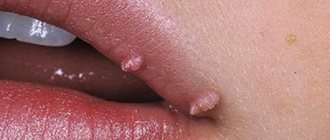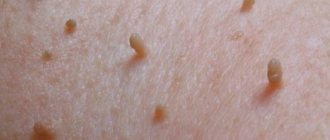What is papilloma?
Development of papilloma on the face
It should be noted right away that papilloma is not cancer, but belongs to the category of benign tumors. These growths generally have a warty appearance, and appear not only on the skin, but can also affect the mucous membranes of the mouth, larynx, vagina, etc.
The culprit of the appearance of neoplasms is the human papillomavirus (or HPV), which easily penetrates into a weakened body. This happens through contact - through handshakes, during sexual intercourse, through damaged skin surfaces (wounds, scratches, abrasions).
Papillomas appear even in children in the form of warts. But they may not appear immediately, having once entered the body - HPV can lurk there for years without showing itself in any way. And only a weakened immune system gives the impetus for the papilloma to begin to grow.
Types of papillomas
- simple warts appear in childhood and adolescence in the form of round-oval growths on the skin up to 2 mm high;
- vulgar warts in children can be seen on the feet, palms, fingers; their height reaches 3 mm, and the surface is covered with scales;
- condylomas acuminata look like a cockscomb or cauliflower; they can grow in the mouth, in the genital area and anus, in the urethra and vagina;
- acrochords are filiform warts that appear in people over 35 years of age; these papillomas have a thin stalk and grow up to 5 mm; appear on the neck, eyelids, under the mammary glands, armpits, and groin.
Doctors find other types of papillomas in internal organs, so they are difficult to notice. Treatment of external formations usually comes down to dermatotherapy and improving immunity. Only in extreme cases do they resort to surgical intervention.
Can papilloma develop into the fatal disease cancer?
Now that we have figured out whether papilloma can disappear on its own, it is necessary to answer an equally important question, whether these formations can degenerate malignantly. It is worth saying that there are several types of HPV (there are more than a hundred of them). Many of them are not dangerous and sometimes even disappear on their own. But there are oncogenic viruses that can lead to malignant degeneration of the growth.
Important! Oncogenic viruses include HPV types 31, 18, 16, 33, 68, 35, 59, 39, 58, 45, 56, 51 and 52.
Typically, types 16 and 18 of HPV cause cancer of the oral cavity, genital organs in men, anal area, vagina, and cervix. The most common diagnosis is cervical cancer, which occurs due to HPV infection. Breast cancer is often associated with the formation of intraductal papillomas, called cystoadenopapilloma and cystoadenoam. These are cyst-like formations with outgrowths in the form of papillae. These formations appear in the epithelium of the milk ducts. The process of their development is very long. It begins during adolescence and ends during menopause.
Surgitron device: principle of operation and areas of application of the radioknife
Reasons for the disappearance of papillomas
Activation of the immune system
In some cases, papillomas may also suddenly disappear as they appeared. But this does not happen with every type of neoplasm. Warts that appear in childhood usually disappear on their own with age under the influence of the immune system.
In adults, the hormonal system also comes into play, the failure of which can provoke the manifestation of certain types of papillomas. Condylomas of a pointed form and papillomas with a thin stalk will not go away on their own, as they are associated with health problems.
If antibiotics are used in the treatment of diseases, their excess can also cause the appearance of papillomas, and most often they appear on the tongue. Once the drugs are completely eliminated from the body, it is hoped that the effect of the papillomavirus may weaken and the growths will go away, but this will take a long period.
HPV treatment and the importance of seeking medical help ↑
The formation of one or more papillomas does not pose virtually any danger, but is a signal that a virus has appeared in the body and is developing. This fact requires an immediate response and a detailed diagnosis of the human body. It should be taken into account that seeking specialized medical care is a mandatory condition that requires strict compliance. This need is dictated by the fact that only a doctor can make the most accurate diagnosis and identify the reasons for the activation of the virus, as well as draw up a treatment plan and determine the advisability of using certain techniques. At the same time, complex therapy, which is the basis for the treatment of HPV and its manifestations, consists of several equivalent vectors aimed at suppressing the infection and neutralizing its symptoms. In such conditions, one of the most important criteria for treatment is compliance with preventive measures. In turn, medication is prescribed only when the papilloma is subject to physical removal.
In most cases, following preventive rules can bring results and save a person from annoying tumors.
Restoring the functions of the immune system can activate the body's protective qualities, which, in turn, will begin to fight infection. At first, such a process is completely invisible, but after some time the results become visible. Papillomas begin to disappear and disappear completely, leaving no trace behind. However, this becomes possible only when a person completely changes his lifestyle and adapts to a new way of existence.
Self-disappearance of papillomas: wait or treat?
Treatment of inflamed papillomas by a dermatologist
Some people do not think about whether papillomas can suddenly disappear on their own. Therefore, they try to speed up the process, without waiting for this event, but also without contacting a doctor. In this case, the skin formations are removed manually, which is strictly forbidden. This will lead to the following consequences:
- at the site of the severed wart, a wound remains, through which infection easily penetrates;
- You shouldn’t completely hope for HPV to disappear - the remaining cells will begin to divide even more actively, and instead of one wart you can get a whole “bouquet”;
- after prolonged healing, an ugly scar will appear on the body, which will cause cosmetic inconvenience.
The most dangerous consequence of self-removal of papillomas is their degeneration into a malignant tumor. But the ongoing process cannot be determined by external signs, and the time required for timely treatment will be missed, which can lead to death.
Even if a person has the patience not to touch the papillomas, you should not wait for them to go away on their own. In any case, you need to visit a doctor (dermatologist, gynecologist, venereologist) to clarify the nature of the neoplasm and make sure that there is nothing dangerous.
After making a diagnosis, the doctor himself will decide whether to prescribe serious treatment or get by with restorative therapy. In any case, the patient will be prescribed immunostimulating and antiviral drugs. Doctors often suggest getting rid of warts using laser, radio waves, liquid nitrogen, cauterization, etc.
Is treatment necessary?
Do small warts need treatment? Or is it better to wait until they disappear on their own? You should not hope for self-healing. In mature patients, papillomas very rarely disappear without treatment.
It is necessary to visit a dermatologist and undergo diagnostics. This is especially necessary if papillomas on the skin and mucous membranes form systematically. After all, such a symptom indicates the presence of HPV in the body. Laboratory diagnostics will help determine the strain of the virus and its oncogenicity.
Factors promoting and preventing the disappearance of papillomas
Vitamins and minerals
The virus penetrates so deeply into the human body that it is not possible to completely destroy it even with the help of drastic measures. Papillomas can disappear on their own if the patient adheres to certain rules:
- it is necessary to constantly stimulate your immune system by using pharmaceutical or homeopathic medicines;
- switch to a balanced diet that supplies the body with vitamins and minerals (supplementing it with dietary supplements);
- observe hygiene standards and avoid questionable contacts;
- give up bad habits (smoking, alcohol, drugs) that affect immunity;
- treat diseases in a timely manner, preventing their protracted course.
But even compliance with all these factors does not guarantee the complete disappearance of papillomas, because HPV is constantly present in the human body. It can remain in a “dormant state” for a long time until it manifests itself again. And the reason for this will be the following moments:
- chronic diseases;
- various infections (even common acute respiratory infections);
- disruptions in the functioning of many organs, and primarily in the gastrointestinal tract;
- physical and mental fatigue;
- taking antibiotics and oral contraceptives.
If at least one of the listed factors is present at the time of treatment of existing papillomas, then the therapy may be ineffective.
What should you pay attention to?
The virus begins to integrate into DNA, and as a result of this process, active synthesis of the same virus begins. Today, a large amount of research is being conducted to prevent the further spread of HPV throughout the body.
Before the virus begins to penetrate the cell, antibodies must surround it, covering it on all sides, preventing further movement. In this way, it is possible to provide an “operative signal” to the macrophage regarding the detection of a foreign element. It absorbs the virus itself, breaking it down into harmless fragments.
Lymphocytes - formed blood cells - begin to “get acquainted” with the split fragments so that they can be recognized in a short time. They begin to carefully analyze every cell in the body. If no extraneous signals are given, then there is no need to worry. If a foreign element is detected, the activity of lymphocytes increases sharply, destroying it.
What to do if the papilloma falls off on its own?
Antimicrobial agent
It should be taken into account that not all growths disappear for the above reasons, but they may fall off. And this usually happens due to the fact that the papilloma on the leg is accidentally caught (with a towel, razor or nail). The remaining warts that have arisen due to a weakened immune system will simply resolve with improved health (but the virus itself will not disappear).
When the condyloma falls off, you will need to take the following measures:
- if there is bleeding, the wound is treated with hydrogen peroxide;
- then it and the area around it are lubricated with an antimicrobial agent, but it should not be colored - it will be more difficult to notice the inflammation that has begun;
- In the place where the papilloma was previously, you need to apply a bactericidal patch.
After taking the steps, you should go to the hospital as soon as possible and undergo an examination. Do not neglect this step - visiting a doctor can save you from serious and dangerous complications.
Can a wart fall off on its own?
A similar phenomenon is quite possible and is more typical for those papillomas that are a formation on a stalk protruding above the surface of the skin.
The process of dying off of papilloma is associated with the active production of antibodies by the body, subject to the restoration of immunity. Sometimes, for this purpose, patients who seek help in the hospital are prescribed immunomodulators. It should be noted that the likelihood of spontaneous disappearance is higher at a young age, and after 30–35 years it is practically reduced to zero.
Why do growths turn black?
Blackening of the papilloma indicates the result of “treatment” using traditional medicine methods, if any were used, and also indicates the abnormal development of the formation, including not degeneration into a malignant formation, although not always.
The likelihood of cancer is indicated by a combination of symptoms: itching in the area of the blackened formation, pain, sulfurous discharge or an unpleasant odor. Therefore, the only correct decision is to seek help from a hospital, undergo the necessary, appropriate tests and, most likely, promptly remove the formation.
Relapse of the disease
Oncological processes occurring in the human body are not fully understood by science. Therefore, it is difficult to predict when a benign formation may go into a malignant stage (and whether it will go at all). But when it comes to the fact that the papilloma has fallen off, you cannot do without an examination.
A secondary infection can be added to HPV, and serious inflammation cannot be avoided. This, in turn, can provoke the virus into more active actions, which will lead not just to the growth of new cells, but will give impetus to the transition of papilloma to another form - melanoma. And this is not just a relapse - it is a death sentence.
Development of human papillomavirus ↑
Initially, it is necessary to understand the development of the disease. Human papillomavirus is a fairly common phenomenon, the carrier of which is 60-65% of the inhabitants of our planet. However, the greatest danger is that in most cases a person does not know about the existence of such problems until HPV enters the active stage and has its destructive effect. This stealth allows this infection to spread freely, causing serious harm to people. Its activation can be triggered by many factors, but the most common is the suppression of the body’s immune characteristics. It is this criterion that is decisive and contributes to the development of infection, as well as the manifestation of its symptoms.
Self-removal
To make the growths dry out and fall off faster, it is necessary to use local preparations or chemicals that destroy tissue affected by the virus. The following remedies are suitable for self-treatment:
- Salicylic ointment;
- Oxolinic ointment;
- Verrucacid;
- Stefalin;
- Panavir;
- Viferon;
- Lapis pencil;
- Ammonia;
- Iodine;
- Celandine.
Most of these substances have an aggressive effect, so they should be used with great caution.
Prevention of recurrence of neoplasms
In order to avoid skin growths, you must adhere to the following rules:
- observe the rules of personal hygiene;
- avoid drying out the skin;
- promptly treat emerging wounds, scratches and other damage to the skin with antiseptic agents to avoid the entry of pathogenic microorganisms;
- eat foods enriched with vitamins;
- use medications only as prescribed by your doctor;
- When a papilloma appears, it is better to remove it.
If a person is not infected with HPV, then he needs to take the choice of a sexual partner very seriously, and also use condoms at the time of intimacy. Because the virus is transmitted primarily through sexual contact.
Papillomas most often disappear on their own in adolescents and pregnant women. If they were formed in adulthood, then the chance of their disappearance decreases. In such cases, it is better to contact a specialist to remove the growth. And in the future, focus your energy on strengthening your immune system.










